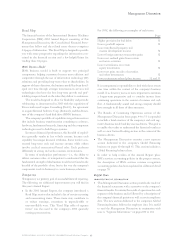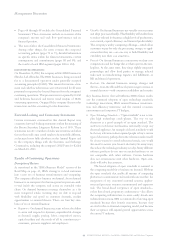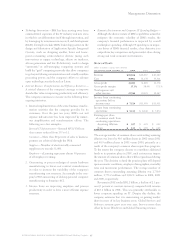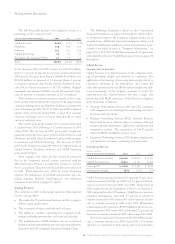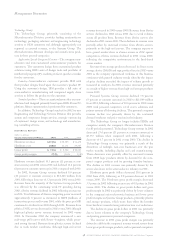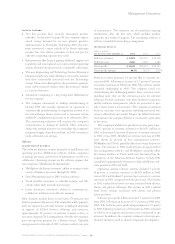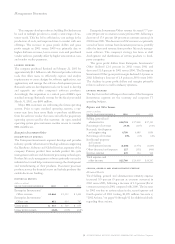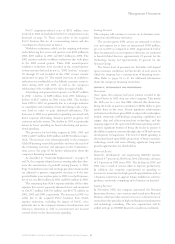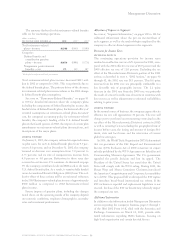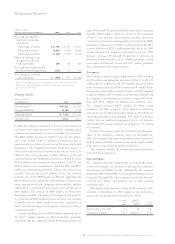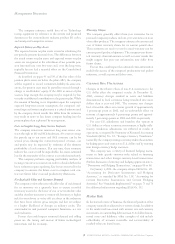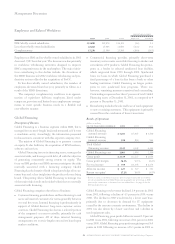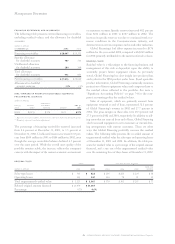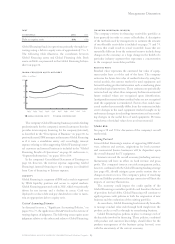IBM 2002 Annual Report Download - page 55
Download and view the complete annual report
Please find page 55 of the 2002 IBM annual report below. You can navigate through the pages in the report by either clicking on the pages listed below, or by using the keyword search tool below to find specific information within the annual report.
The amounts disclosed in this retirement-related benefits
table are for continuing operations.
(dollars in millions)
for the year ended december 31: 2002 2001*2000*
Total retirement-related
plans
—
income $«(248) $«(493) $«(389)
Comprise:
Defined benefit and
contribution pension
plans
—
income $«(619) $«(886) $«(776)
Nonpension postretirement
benefits
—
cost 371 393 387
*Reclassified to conform with 2002 presentation.
Total retirement-related plans income decreased $245 mil-
lion in 2002 as compared to 2001. This was primarily due to
the defined benefit plans. The primary driver of the decrease
in retirement-related plans income relates to the 2002 change
in defined benefit plan assumptions.
See note w, “Retirement-Related Benefits,” on pages 95
to 100 for detailed information about the company’s plans
including the components of defined benefit plan income, the
funded status of defined benefit plans, the historical effects of
actuarial assumptions on retirement-related plans (income)/
cost, the company’s accounting policy for retirement-related
benefits, the company’s funding of the U.S. defined benefit
plan in the fourth quarter of 2002, the impact of certain plan
amendments on retirement-related plans (income)/cost, and
descriptions of the major plans.
looking forward
On January 1, 2003, the company reduced its expected return
on plan assets for its U.S. defined benefit plan from 9.5 per-
cent to 8.0 percent, and on December 31, 2002, the company
lowered its discount rate assumption from 7.0 percent to
6.75 percent, and its rate of compensation increase from
6.0 percent to 4.0 percent. Reductions in these rates also
occurred in certain non-U.S. countries. As discussed on page
99, the company contributed cash and IBM stock to the main
U.S. defined benefit plan. As a result, it remains fully funded
on an Accumulated Benefit Obligation (ABO) basis. The col-
lective effect of these actions will be an estimated reduction
in the 2003 Retirement-related plans income of approximately
$500 million as compared to 2002 Retirement-related
plans income.
Future impacts of pension plans, including the changes
noted above, on the operating results of the company depend
on economic conditions, employee demographics, mortality
rates and investment performance.
Allocation of Expense to Segments
See note x, “Segment Information,” on pages 100 to 104 for
additional information about the pre-tax income/(loss) of
each segment, as well as the methodologies employed by the
company to allocate shared expenses to the segments.
Provision for Income Taxes
historical results
The continuing operations provision for income taxes
resulted in an effective tax rate of 29.1 percent for 2002, com-
pared with the 2001 effective tax rate of 28.9 percent and the
2000 effective tax rate of 31.0 percent. Excluding the tax
effect of the Microelectronics Division’s portion of the 2002
actions as described in note s, “2002 Actions,” on pages 90
through 92, the 2002 rate was 29.5 percent. This 0.6 point
increase from the 2001 rate was principally attributable to a
less favorable mix of geographic income. The 2.1 point
decrease in the 2001 rate from the 2000 rate was primarily
the result of a more favorable mix of income in countries with
low tax rates as well as adjustments to estimated tax liabilities
relating to prior years.
looking forward
In the normal course of business, the company expects that its
effective tax rate will approximate 30 percent. The rate will
change year to year based on nonrecurring events (such as the
tax effect of the Microelectronics Division’s actions in 2002)
as well as recurring factors including the geographical mix of
income before taxes, the timing and amount of foreign divi-
dends, state and local taxes, and the interaction of various
global tax strategies.
In 2001, the World Trade Organization (WTO) determined
that tax provisions of the FSC Repeal and Extraterritorial
Income (ETI) Exclusion Act of 2000 constitute an export
subsidy prohibited by the WTO Agreement on Subsidies and
Countervailing Measures Agreement. The U.S. government
appealed the panel’s decision and lost its appeal. The
President of the United States has stated that the United
States will comply with the WTO ruling. During 2002, the
House Ways and Means Committee Chairman introduced
the American Competitiveness and Corporate Accountability
Act of 2002. This proposed bill would repeal the ETI regime
and introduce broad-based international tax reform. If the
ETI exclusion is repealed and replacement legislation is not
enacted, the loss of the ETI tax benefit may adversely impact
the company’s tax rate.
Additional Information
In addition to the information in this Management Discussion
section regarding the company’s business, pages 1 through 3
of the IBM 2002 Form 10-K, filed with the Securities and
Exchange Commission on March 10, 2003, provide addi-
tional information regarding IBM’s business, focusing on
high-level organization and certain key risk factors.
Management Discussion
53international business machines corporation and Subsidiary Companies


